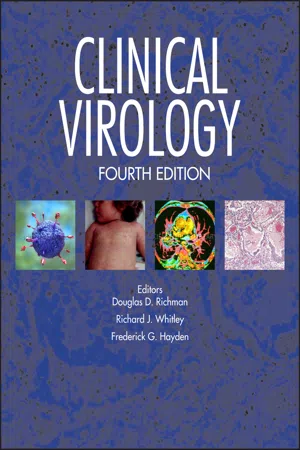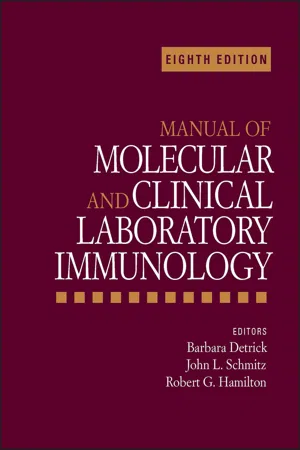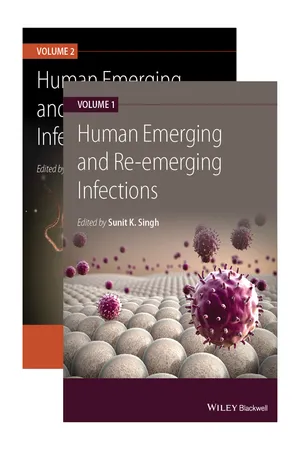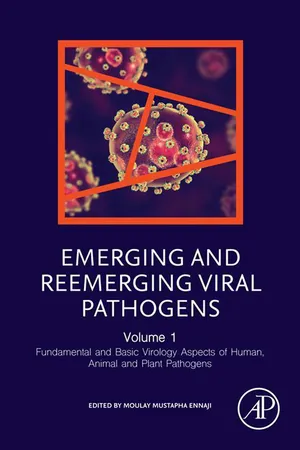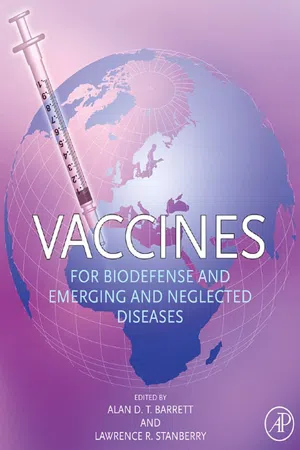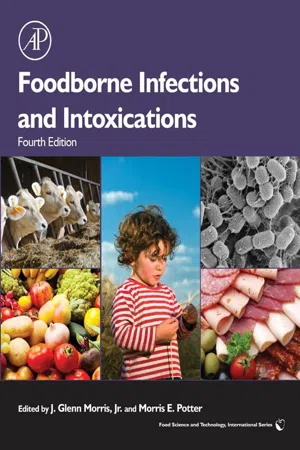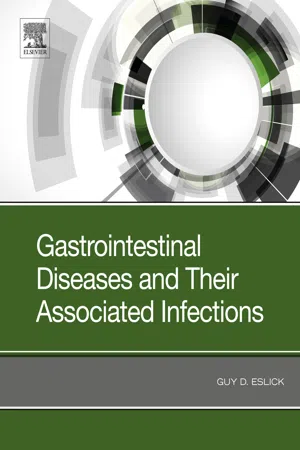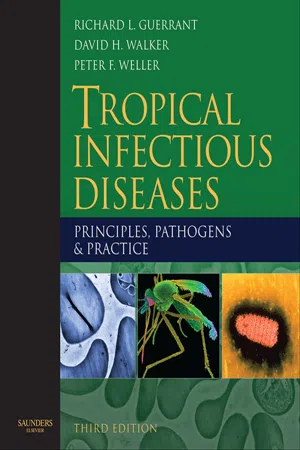Biological Sciences
Rotavirus
Rotavirus is a highly contagious virus that causes gastroenteritis, particularly in young children. It is transmitted through the fecal-oral route and can lead to severe diarrhea and dehydration. Vaccines are available to prevent rotavirus infection, and supportive care, such as rehydration therapy, is important for managing the symptoms.
Written by Perlego with AI-assistance
9 Key excerpts on "Rotavirus"
- eBook - ePub
- Douglas D. Richman, Richard J. Whitley, Frederick G. Hayden, Douglas D. Richman, Richard J. Whitley, Frederick G. Hayden, Douglas D. Richman, Richard J. Whitley, Frederick G. Hayden(Authors)
- 2016(Publication Date)
- ASM Press(Publisher)
6 ).FIGURE 1 Map of the world showing Rotavirus mortality in 2008, reproduced with permission from (5 ).Rotaviruses do not account for a substantial number of deaths in developed countries, probably because of efficient and widespread access to rehydration and other supportive measures. Moreover, with the advent of Rotavirus vaccines the impact of this pathogen has diminished in recent years in most developed countries. For example, in the United States detection of Rotaviruses and costs for associated treatment have drastically diminished after vaccine introduction (7 , 8 ). Although Rotavirus was still identified in 12% of children with acute gastroenteritis in 2009 and 2010, during the same period norovirus replaced Rotavirus as the leading cause of medically attended acute gastroenteritis in U.S. children (9 ). A similar situation may be occurring in some developing countries, as exemplified in Nicaragua where the epidemiology of diarrhea is changing (10 ).VIROLOGY
Classification
Rotaviruses belong to the Reoviridae family of icosahedral, nonenveloped, segmented double-stranded (ds) RNA viruses. Rotaviruses are classified into five groups (A through E) depending on the presence of cross-reactive antigenic epitopes primarily located on the internal structural protein VP6. Among these, Group A Rotaviruses (RVA) are the most frequent pathogens of humans, and groups D and E have been found only in nonhuman animals. Unless otherwise noted, this chapter will address only RVA. Group B Rotaviruses (RVB) are sporadic pathogens of animals but have been implicated in several large outbreaks of adult diarrhea in China in the 1980s and less frequently in the 1990s (11 ). More recently, they have been identified in children and adults with diarrhea in India and Bangladesh (12 , 13 ). Group C Rotaviruses (RVC) are primarily veterinary pathogens but have been reported to be sporadically associated with diarrhea in children. The seroprevalence of these Rotaviruses is relatively high in humans, especially those living in rural areas, suggesting transmission from animals to humans (14 ). However, in some countries such as India, prevalence of antibodies against RVC is the same in urban and rural populations (15 - eBook - ePub
- Jiri Mestecky, Michael E. Lamm, Pearay L. Ogra, Warren Strober, John Bienenstock, Jerry R. McGhee, Lloyd Mayer(Authors)
- 2005(Publication Date)
- Academic Press(Publisher)
This chapter reviews three enteric viral infections of humans in which the primary or sole site of viral replication and the underlying mechanisms of pathogenesis result from local infections in the cells of the gastrointestinal tract. Rotaviruses, human caliciviruses, and astroviruses are considered, with emphasis on Rotaviruses because of their significant clinical impact in children and because Rotavirus vaccines are in phase III trials and the furthest toward licensure. Immunity for these enteric viruses is complex, but studies on immunization and vaccine development involving these viruses are clearly useful as models for probing virus–cell interactions in the gastrointestinal tract and for learning how to induce mucosal immunity to prevent local infections.RotavirusES
Introduction
Rotaviruses are the single most important cause of severe infantile gastroenteritis. In the United States alone, these viruses are estimated to cause 50,000 to 100,000 hospitalizations in young children each year and approximately 20 to 40 deaths. On a world scale, Rotaviruses are estimated to be responsible for nearly 1 million deaths annually (Kapikian et al., 2001). Cost estimates for hospitalizations due to Rotavirus infections in the United States are greater than $300 million each year, and this does not account for the cost of doctors’ visits and home care associated with 2 million less severe Rotavirus illnesses. For these reasons, Rotaviruses have received a high priority as a target for vaccine development.Rotavirus transmission occurs by the fecal–oral route, providing a highly efficient mechanism for universal exposure that has circumvented differences in regional and national cultural practices and public health standards. The symptoms associated with Rotavirus disease are typically diarrhea and vomiting, accompanied by fever, nausea, anorexia, cramping, and malaise, which can be mild and of short duration or produce severe dehydration. Severe disease occurs primarily in young children, most commonly between 6 and 24 months of age. Approximately 90% of children in both developed and developing countries experience a Rotavirus infection by 3 years of age. Rotavirus infection normally provides short-term protection and immunity against subsequent severe illnesses but does not provide life-long immunity, and there are numerous reports of sequential illnesses. Neonates can also experience Rotavirus infections, and these occur endemically in some settings but are typically asymptomatic. These neonatal infections have been reported to reduce the morbidity associated with a subsequent Rotavirus infection (Bishop et al., 1983;Bhan et al., 1993). Rotavirus illnesses also occur in adults and the elderly, but the symptoms generally have been believed to be mild. A recent study conducted in Japan, however, suggests that Rotaviruses are a major cause of hospitalization of adults due to acute diarrhea (Nakajima et al., - Barbara Detrick, John L. Schmitz, Robert G. Hamilton, Barbara Detrick, Robert G. Hamilton, John L. Schmitz(Authors)
- 2016(Publication Date)
- ASM Press(Publisher)
Table 1 . Although the field of diagnostic virology is advancing rapidly, with multipathogen formats gaining widespread use, the techniques described here for individual viral pathogens will continue to provide important information on the epidemiology, natural history, and evolution of these viruses.TABLE 1 Common viral agents of gastroenteritis identified in stoolaRotavirusES
Overview
Rotavirusesare a major cause of acute gastroenteritis in humans and animals. They have a double-stranded RNA genome divided into 11 segments that encode the viral proteins: 6 structural proteins (VP1 to VP4, VP6, and VP7) and at least 5 nonstructural proteins (NSP1 to NSP5) (Fig. 1A ) (1 ). The Rotavirus segmented genome is enclosed within a triple-layered protein icosahedral capsid, in which the inner capsid is formed by the VP2, the intermediate capsid by the VP6, and the outer capsid by the VP7 and VP4 (Fig. 1A ). Based on differences within the VP6 protein, Rotaviruses can be divided into nine groups (A to I) (2 ), with group A Rotavirus (RVA) the most prevalent (> 99% of the isolates) in humans (1 ).FIGURE 1 Rotavirus genome and genotype distribution. (A) Representation of Rotavirus virion, proteins, and double-stranded RNA gene segments. Proteins are color coded, and genes used for typing are highlighted with corresponding colors. The Rotavirus virion was modeled using crystal coordinates from VP2, VP6, VP7, and VP4 proteins (PDBs: 3IYU and 3N09) and visualized in Chimera. (B) Global incidence of the most predominant Rotavirus strains in humans according to genotype. Numbers represent the percentage of total strains included (n = 16,474). (Adapted from reference 5 .)Antigenic and genetic differences within the two outermost proteins, VP4 and VP7, have been used to classify RVA by a dual nomenclature system into P and G types, respectively. Currently, 37 P types and 27 G types have been described in different animal species (3 , 4 ). Surveillance of RVA in humans has shown that five strains (G1P[8], G2P[4], G3P[8], G4P[8], and G9P[8]) are the most common (Fig. 1B ), but temporal and geographic changes in strain prevalence as well as the emergence of strains bearing unusual G types (e.g., G8, G10, or G12) have been observed (1 , 5 ). Based on full-genome sequencing and differences within each of the 11 segments, a comprehensive classification system has been established for RVA. This system recognizes the genomic characteristics of RVA from different species and defines the presence of three major genomic constellations, with two prevalent in humans (WA-like and DS1-like) and one in animals (AU1-like) (6- eBook - ePub
- Sunit Kumar Singh, Sunit Kumar Singh(Authors)
- 2015(Publication Date)
- Wiley-Blackwell(Publisher)
Chapter 12 Pathogenesis of Rotavirus in Humans Carlos Fernando Narváez1 , Martha C. Mesa2 , Alfonso Barreto2 , Luz-Stella Rodríguez3 , and Juana Angel31 Facultad de Salud, Programa de Medicina, Universidad Surcolombiana, Neiva, Colombia2 Departamento de Microbiología, Facultad de Ciencias, Pontificia Universidad Javeriana, Bogotá, Colombia3 Instituto de Genética Humana, Facultad de Medicina, Pontificia Universidad Javeriana, Bogotá, Colombia12.1 Introduction
12.1.1 Morphology
In Latin, rota means “wheel” and this is the shape of a Rotavirus (RV), as seen by electron microscopy. The non-enveloped, viral particles have a diameter of approximately 100 nm with an icosahedral structure T = 13l. It is formed by three concentric protein layers, surrounding the viral genome made up of 11 segments of double-stranded RNA (dsRNA), which code for 6 viral structural proteins (VPs) and 6 non-structural proteins (NSPs) (see Figure 12.1 ). Each RNA segment codes for only one protein, except segment 11, which codes for NSP5 and NSP6 in some viral strains (Greenberg and Estes, 2009). The viral core is made of 120 copies of VP2 containing the genome, VP3 (with guanylyltransferase and methyltransferase) and VP1 (RNA-dependent RNA polymerase) associated with each dsRNA segment. The viral genome packed in the core is approximately 0.7–3.3 kb in size. The intermediate layer is formed of 260 dimers of VP6, the most abundant VP. The viral particles formed by VP1, VP2, VP3, and VP6 are called double-layered particles (DLPs). The external and third viral layer is formed by trimers of VP7 (calcium binding glycoprotein) and a spike protein VP4, which interacts with the intermediate layer by binding VP6. Trimerization of VP7 is calcium dependent. All VPs have auto-assembling capacity to form the triple-layered particles (TLPs) (Trask et al., 2012).Fig. 12.1 - eBook - ePub
Emerging and Reemerging Viral Pathogens
Volume 1: Fundamental and Basic Virology Aspects of Human, Animal and Plant Pathogens
- Moulay Mustapha Ennaji(Author)
- 2019(Publication Date)
- Academic Press(Publisher)
Chapter 45Worldwide Emerging and Reemerging Rotavirus Genotypes: Genetic Variability and Interspecies Transmission in Health and Environment
Rihab Bouseettine1 , Najwa Hassou1 , A. Hatib1 , B. Berradi2 , Hlima Bessi1 and Moulay Mustapha Ennaji1 ,1 Laboratory of Virology, Microbiology, Quality, Biotechnologies/Eco-Toxicology and Biodiversity, Faculty of Sciences and Techniques, Mohammedia, University Hassan II of Casablanca, Casablanca, Morroco,2 Laboratory of Cellular and Molecular Pathologies, Faculty of Medicine and Pharmacy, University Hassan II of Casablanca, Casablanca, MoroccoAbstract
Rotavirus (RV) is the causative agent of infectious diarrhea, severe in children in the world. It is a double-stranded ribonucleic acid virus belonging to the family Reoviridae (RV). Almost all the children in the world are infected by the RV at least once by the age of 5 years.This virus has a short incubation period of not exceeding 3 days. It is known by its transmission from person to person by the fecal–oral route. In developing countries the RV can also be transmitted by water contaminated by fecal materials. It is also suspected that the RV can spread from one child to another via the contamination by the infected surfaces.The genus Rotavirus belongs to the family Reoviridae. It is composed of seven serogroups, RV A–G, including RV A–C, that infect humans, mainly the Group A.To date, 15 G (glycoprotein) and 27 P (protease sensible) genotypes have been described. Studies of RV strains have demonstrated that the genes G1–G4 are the most common circulating G types. In the 1900s a new genotype, G9, appeared in 1983 and is now quite known worldwide. Several researchers have found a novel G12 RV. This gene presents a high prevalence due to its association with multiple VP4 genotypes. In addition, several other RV strains have demonstrated regional predominance. G5 RVs, previously found only in pigs and horses, were detected in Brazilian children in 1983 and have since been regularly reported from Brazil at a high incidence. Similarly, G8 RVs have been detected all over the African continent, especially in Malawi. - Alan D.T. Barrett, Lawrence R. Stanberry(Authors)
- 2009(Publication Date)
- Academic Press(Publisher)
1974 ). Within a short time other investigators confirmed the association between the presence of Rotavirus in feces and acute gastroenteritis.In addition to their distinctive morphologic features, human Rotaviruses along with their animal counterparts, share a group antigen (Kapikian et al., 1976 ; Woode et al., 1976 ) and are classified as members of the Rotavirus genus within the Reoviridae family (Matthews, 1979 ). In 1980, particles that were morphologically indistinguishable from established Rotavirus strains but lacked the common group antigen were discovered in pigs (Bridger, 1980 ; Saif et al., 1980 ). This finding led to the identification of Rotaviruses belonging to six additional groups (B–G) based on common group antigens, with the original Rotavirus strains classified as group A (Saif and Jiang, 1994 ). Only groups A–C have been associated with human diseases, and most known cases of Rotavirus gastroenteritis are caused by group A strains. Although, there have been large outbreaks reported in China and Japan associated with nongroup A strains, particularly among adults (Hung, 1988 ; Kuzuya et al., 1998 ; Matsumoto et al., 1989 ), group A Rotaviruses are the strains to which vaccine development has been directed.Properties of the Virus
Rotavirus is a double-stranded RNA virus. The genome segments of Rotavirus can be extracted from viral particles and separated by polyacrylamide gel electrophoresis into 11 bands visualized by ethidium bromide or silver staining as shown in Fig. 35.2 . Each Rotavirus strain has a characteristic RNA profile or electropherotype, a property that has been used extensively in epidemiologic studies of these viruses. The characteristic RNA electrophoretic pattern of group A Rotaviruses consists of four size classes containing segments 1–4, 5 and 6, 7–9, and 10 and 11 (Kapikian et al., 2001 ). A short pattern is seen when the segment 11 runs slower than segment 10. RNA segments of strains belonging to less well characterized Rotavirus groups (i.e., groups B–G) also can be separated into four size classes, but the distribution of segments within these classes differs from group to group (Saif, 1990- eBook - ePub
- J. Glenn Morris Jr.(Author)
- 2013(Publication Date)
- Academic Press(Publisher)
13] .Microbiology
Rotavirus structure
Rotavirus, named for its wheel-like appearance (from the Latin word rota meaning “wheel”), is a non-enveloped virus belonging to the Rotavirus genus of the Reoviridae family. The Rotavirus genome is composed of 11 segments of double-stranded ribonucleic acid (RNA), with each segment coding for a non-structural or structural viral protein (VP). The genome is protected by three concentric protein layers: the inner core, an internal capsid, and an outer coat (Figure 21.1 ). The inner core is composed of VP1, VP2, and VP3, and encloses the genome. The inner core is surrounded by an internal capsid, comprised mainly of VP6. The outermost layer, or outer coat, is made of VP7 and VP4, which form the protein shell and protruding spikes around the virion, respectively. VP7 and VP4 induce type-specific neutralizing antibodies involved in protective immunity, and are used to define serotype nomenclature.Figure 21.1 Schematic representation of a Rotavirus particle structure [14] .Rotavirus classification
Rotaviruses are classified into serotypes based on the VP7 and VP4 outer capsid antigens. VP7, a g lycoprotein, is also referred to as the “G-type antigen,” while VP4, a protease-sensitive protein, is referred to as the “P-type antigen.” Ten G serotypes and 11 P genotypes are important for humans, with G1 and P[8] being the most common worldwide and in the USA. The segmented nature of the Rotavirus genome allows for gene re-assortment, allowing for the possibility of multiple G and P protein combinations. For example, a novel Rotavirus strain, thought to be derived from zoonotic (porcine) transmission with subsequent re-assortment, has been shown to cause illness [15] - Guy D. Eslick(Author)
- 2019(Publication Date)
- Elsevier(Publisher)
Other viruses that have demonstrated some association with diarrhea are Aichi virus, torovirus, and picobirnaviruses. 13 New viruses detected in the gastrointestinal tract by next generation sequencing with an unknown association with diarrhea include novel astroviruses, Saffold virus, Cosavirus, Klassevirus/Salivirus, novel polyomaviruses, Bufavirus, Tusavirus, and Recovirus. 13 This chapter will focus on the epidemiology, diagnosis, and management of the five most common enteric viruses associated with diarrhea. Enteric Viruses Rotavirus Rotaviruses are classified within the virus family Reoviridae. The genome consists of 11 individual segments of double-stranded (ds) RNA (18 500 bp in total) enclosed by three protein layers: the core, inner capsid, and outer capsid (Fig. 11.1A). The proteins of the inner and outer capsid layers include epitopes that aid in the classification of RV strains. Epitopes on the inner capsid protein (VP6) allow classification of RVs into eight species (termed RVA–RVH). Epidemiological studies have shown that group A RVs are commonly associated with human disease. 14 FIG. 11.1 Negatively-stained, pathogenic virions with characteristic morphologies of: (a) Reoviridae, Sedovirinae, Rotavirus; (b and c) Caliciviridae, Norovirus; inset: Vesivirus; (d) Adenoviridae, Mastadenovirus — arrows indicate the ends of pentameric fibres; (e) Asteroviridae, Astrovirus — arrow highlights a particle with taxonomically relevant starry appearance. Scale bars = 30 nm- Richard L. Guerrant, David H. Walker, Peter F. Weller(Authors)
- 2011(Publication Date)
- Saunders(Publisher)
14 have led to new insights into the role of astrovirus in human disease. It is now clear that astroviruses are a common cause of sporadic gastroenteritis among children and may be associated with large-scale outbreaks of diarrhea as well.Astroviruses are 28–30 nm, spherical, nonenveloped viruses with a positive sense ssRNA genome and have been classified in their own family, Astroviridae .15 Eight serotypes of human astroviruses have been identified.16, 17 Of these, type 1 is predominant in most studies, accounting for more than half of strains isolated;16, 18, 19 types 2, 3, and 4 each account for 10–16% of astrovirus detections; and types 5, 6, 7, and 8 are less uncommonly detected.16, 17 The relative distribution of types seems to vary by geographic location and by year,20 and more variability may be found in developing countries.21, 22Epidemiology
Gastroenteritis associated with astroviruses has been reported worldwide, both as sporadic disease and as outbreaks. Cases of astrovirus-associated gastroenteritis are most common among children less than 2 years of age,19, 21 - 32 and are less frequent among older children and adults.33, 34 In volunteer studies, most adults neither became infected nor developed diarrhea.33, 35 However, in large outbreaks among schoolchildren,36, 37 teachers became ill as well, perhaps as a result of a large dose of virus in this type of setting or a different mechanism of spread. In addition, outbreaks have been reported among elderly people, probably due to waning immunity with increasing age.38 - 40
Index pages curate the most relevant extracts from our library of academic textbooks. They’ve been created using an in-house natural language model (NLM), each adding context and meaning to key research topics.
Explore more topic indexes
Explore more topic indexes
1 of 6
Explore more topic indexes
1 of 4
